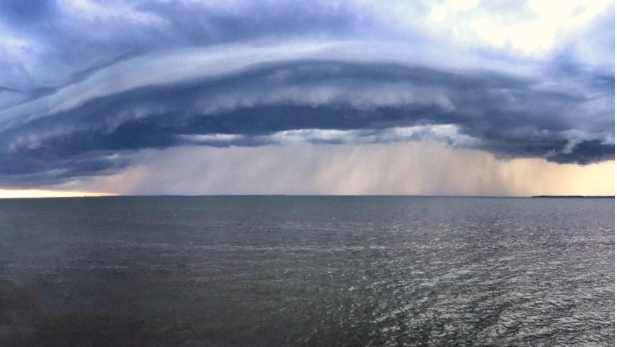 We had a run of sultry days last week. To walk the golf course was to take a shower with my clothes on, something I don’t usually do. The air was so wet, you could wring it out with a tea towel. Ah, summer on the Eastern Shore.
We had a run of sultry days last week. To walk the golf course was to take a shower with my clothes on, something I don’t usually do. The air was so wet, you could wring it out with a tea towel. Ah, summer on the Eastern Shore.
But then, to paraphrase Ray Bradbury, something wicked this way came. My friend Richard who lives in a castle on the Bay out in Tolchester was the first to report a sighting: a summer squall moving fast and low across the water heading straight for Kent County. I checked the radar app on my phone: sure enough—a thin band of strong showers descending on us from the northwest. Batten down the hatches.
My wife and I were sitting on the front porch at the time. (I know: you’re shocked!) We had just been talking about how still it was when we first felt a breath of air. Then we heard the leaves of the sycamore begin to rustle. The flag which had been hanging limp suddenly snapped to attention. A few fat drops of rain fell, the temperature dropped like a rock, and suddenly we were pulling pillows and heading for the door just in time. An ominous wall of wind and rain and sound hit all at once, a big tree limb crashed onto the roof; we went from all calm to apocalypse in a matter of seconds. It was thrilling—from our inside vantage point!
And then it was gone. The squall fled across the Chester and down through Queen Anne’s County like a drunk in a roadster careening down the highway. And in its surprisingly benign wake: cooler temperatures, drier air, and rainbows. Rainbows everywhere. FaceBook and Instagram exploded with photographs of rainbows as though the Wizard himself had saved us all from imminent disaster. Everything’s OK, folks; Dorothy can go back home to Kansas now.
According to the National Weather Service, a squall is nothing more than a highly localized “active weather” event characterized by a sudden, sharp increase in wind speed usually accompanied by rain, thunderstorms, or even snow. Squalls are caused by mid-level tropospheric cooling which creates an upward warm air motion at the leading edge of the storm, followed by enhanced downward motions of cooler air in its wake. To make a squall official in the eyes of the NWS, wind speed must increase by at least 8mph per second, attain a top speed increase of at least 11mph per second, and last at least one minute which when you’re clearing the porch and running for the door seems like an eternity. (In Australia, a squall must last at least “several” minutes to officially earn its stripes. It’s tougher Down Under, mate!)
But by now, you know that when I look at a squall, I don’t see a weather event; I see a metaphor. Squalls happen. They can be unpredictable and scary—even dangerous—in their intensity and if they’re strong enough, they can leave detritus and destruction in their wake. Clean-up can take time. But they do clear the air and usually, there’s a post-squall rainbow to seal the deal.
My wife and I have been known to bicker lovingly from time-to-time. In all our years together, I can think of only one squall and it was my fault. I never saw it coming but fortunately for me, she is a kind-hearted soul and quick to forgive so almost as fast as it was on us, it was over. I’ll forecast better next time.
As for the squall that came through Sunday night, I’m just glad we were on the porch and not out on the water in a boat. Hope everyone came through safely and saw the rainbows!
I’ll be right back.
Jamie Kirkpatrick is a writer and photographer with homes in Chestertown and Bethesda. His work has appeared in the Washington Post, the Baltimore Sun, the Pittsburgh Post-Gazette, the Philadelphia Inquirer, the Washington College Alumni Magazine, and American Cowboy magazine. “A Place to Stand,” a book of photographs and essays about Landon School, was published by the Chester River Press in 2015. A collection of his essays titled “Musing Right Along” was published in May 2017; a second volume of Musings entitled “I’ll Be Right Back” will be released in June 2018. Jamie’s website is www.musingjamie.com.



[…] The Squall by Jamie Kirkpatrick […]